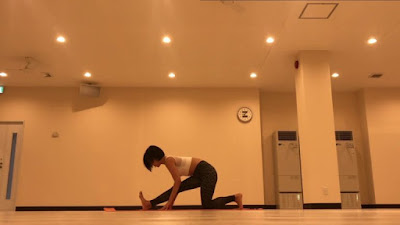Strengthens your hamstrings.Half Front Splits Pose
Ardha hanumanasana (are-dah hah-new-mahn-AHS-anna), also known as half front splits pose, is a great stretch for your hips, hamstrings, calves, and lower back. An approachable posture for most individuals, ardha hanumanasana strengthens the muscles needed to practice front splits safely with the correct muscles properly engaged.
STEP-BY-STEP:
- Start in a lunge with your right foot forward and your back knee on the ground. Shift your hips back to stack over your left knee, and straighten your front leg to a place where you feel a stretch, but not strain.
- Flex your right toes toward your face so that the sole of your foot is off the mat. Place your hands directly under your shoulders, either on the floor or on blocks. Make sure you keep length in your spine, both front and back.
- Keep your right kneecap pointed directly up, with at least a small bend behind your knee to prevent hyperextension. Engage your quadriceps.
- Press down through your fingertips to keep length in the torso and engage the muscles in your belly.
- To deepen the stretch, begin to walk your hands toward your feet. As you work in the pose, focus on pulling the pinky toe of your right foot back towards your face and pressing forward with the ball of your foot right under the big toe.
- Hold the pose for up to 60 seconds before re-bending the front knee and returning to a lunge. Repeat on the other side.
Philosophy + Origin
One of the main characters of the Ramayana is Hanuman, the famous monkey god, devotee of Lord Rama, and son of Vayu (the god of wind). He is celebrated in the pose hanumanasana, which physically represents his famous “leap of faith,” taking him across the ocean from India to the Himalayas. Of course, this leap didn’t happen overnight. Ardha hanumanasana, the preparatory pose for hanumanasana, can represent the stability and strength needed to make grand, world-changing (or life-changing) gestures. Rather than only focusing on gaining flexibility, use ardha hanumanasana to create a healthy balance of flexibility and strength. When practicing ardha hanumanasana, remind yourself of the dangers of only being flexible in life. In order to really get where you want to go, you must also be strong and stable.
ADJUSTMENTS/MODIFICATIONS:
- Use blocks under the hands to help keep the torso erect and the spine long.
- Keep the hands directly under the shoulders.
- As flexibility increases, try walking the hands down the extended leg towards the feet.
CONTRAINDICATIONS AND CAUTIONS:
- Back injuries or back pain, especially in the lower back
- Hip, hamstring, or groin injury
TIPS:
One of the underlying benefits of practicing ardha hanumanasana is its ability to teach proper muscular engagement. Because hanumanasana can be so intense (or so easy), it is often practiced poorly when it comes to alignment and physical engagement. While working in ardha hanumanasana, pay attention to your muscles, especially around the pelvis. Rather than collapsing into the joints–which puts muscles and joints at risk–learn to be active rather than passive. Focusing on the right muscular actions can relieve discomfort around the inner knees, the SI joints, and hamstring attachments.











댓글
댓글 쓰기